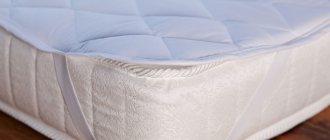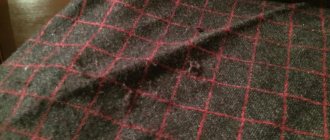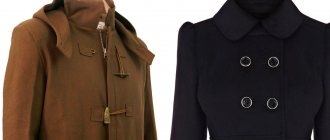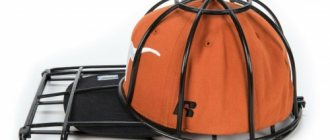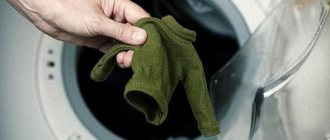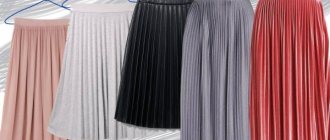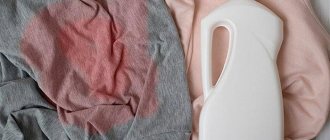What is it that clothes are not made from today? Made from acrylic, wool, elastane, cotton... You can't list everything. Each fabric requires special care. But it is simply impossible to remember all the details for each matter. In addition, it is not always possible to determine by eye what, for example, a jacket is filled with - padding polyester, down or holofiber. This makes it difficult to choose the right care. To prevent housewives from using trial and error, manufacturers have come up with special “care” badges. They are on the label. From the pictures you can get complete information on how to handle the textile product and what not to do. If you follow the recommendations, your clothes will remain presentable for an order of magnitude longer. And this is savings.
On coats and jackets, the tag can be found inside - on the side of the waist or in the inside pocket. In trousers they look for the tag on the back seam or on the side, and in shirts, dresses, T-shirts - under the collar at the back or on the side seam.
Basic character groups
Garment care icons are divided into five groups. Classification is carried out according to the action that can (or cannot) be carried out with the product. The group symbols and their meaning are presented in the table.
Table - Pictures to indicate groups, their meaning
| Drawing | Meaning |
| Basin with water | Washing rules |
| Square | Drying Features |
| Triangle | Is it possible to bleach |
| Circle | Professional cleaning (yes/no) |
| Iron | How to iron |
If the drawing is underlined, then the procedure for which it is “responsible” must be carried out carefully. Two lines below the image indicate that the product requires special delicate handling. Crossing out an icon indicates that the manipulation it represents cannot be done.
"P" sign on a clothing label
Care labels on clothing labels are very important.
After all, each fabric (fabric composition) has its own unique care. To prevent premature damage and wear of your favorite item, you need to choose the appropriate care for it: washing, ironing, dry cleaning, etc. The care symbols for dry cleaning textiles are usually written on the sew-in label along with the fabric composition and the name of the manufacturing company. In Russia, there is a legalized standard of symbols for the care of textile products, prescribed in GOST 16958-71. All care symbols can be divided into several groups. But over time, more and more new materials began to appear, and, consequently, new symbols of care signs.
- wash
- whitening
- ironing
- dry cleaning
- machine drying
View in detail:
Decoding labels on clothes
Signs on clothing labels and their meaning
Triangle sign on a clothing label
"Wash" sign on a clothing label
— Dry cleaning. Corresponds to the "empty circle" symbol. Professional care of the product using dry professional cleaning products is allowed. — Cleaning with any solvent — the letter “A” in a circle. The item can be cared for by dry cleaning using any organic solvent. — Cleaning with any solvent other than trichlorethylene —letter designation “P” in a circle. Dry cleaning is allowed only with hydrocarbons, ethylene chloride, monofluorotrichloromethane, except for the reagent - trichlorethylene. - Gentle cleaning. Complements the usual dry cleaning sign with 1 line. In this case, gentle solvents are used, self-drying is prohibited. — Cleaning with mild solvents. Accompanying the dry cleaning mark with the letter F means that cleaning is permitted with reagents such as hydrocarbons and trifluorotrichomethane, and also implies control of mechanical stress and drying temperature. - Chem. cleaning is prohibited. The product must not be dry cleaned, nor can stains be removed using chemical solvents.
If you are in doubt about the correct choice of care marks for the items you produce, we advise you to contact the specialists at our company. We have been producing compound labels for over 20 years. Our team of professionals will help you with any issue related to tags and labels.
Cost of producing printed labels Moscow
In our company you can order, buy, and print textile labels. Our label production is ready to print custom labels with your logo or composition in the shortest possible time. The price for producing printed labels with your logo varies depending on the desired size, type of base tape, number of colors used, type of dye, etc. If you are ordering printed labels with a complex image (colour alignment, small details, font smaller than 1.5-2 mm, thin lines, etc.) we recommend ordering a sample.
View in detail:
Basic file requirements
To clarify the cost, you need to contact our managers.
Decoding the icons on clothes for washing
Labels on clothes for washing usually come first. They inform you whether the product can be washed, which wash is preferable, and what temperature conditions are suitable. Correctly deciphering the washing symbols on the label will help you care for the product as recommended by the manufacturer. If you wash an item as you please, without paying attention to the recommendations, it will quickly lose its presentation. Therefore, deciphering the signs for washing on clothes is so important, and the following table will help the housewife understand this issue.
Table - Symbols for washing and their meaning
| Symbol | Meaning |
| — A sign allowing both machine and hand washing; - rinsing and soaking is acceptable | |
| — A sign allowing only hand washing; — water temperature should not exceed 40°C; - you cannot rub the item intensively; - unscrew - with caution | |
| — A sign that says washing is prohibited; - Dry cleaning is acceptable | |
| — Any mode is acceptable, up to boiling at 95°C | |
| — The product must be washed and wrung out carefully; — recommended temperature — 30°C | |
| - Delicate wash; — recommended temperature — 30°C; - you can’t push up intensely |
Manufacturers use not only canonical, but also modified symbols on clothes for washing. For example, the temperature regime is often indicated not by numbers, but by dots. This can confuse the owner. In fact, such symbols on clothes for washing are easy to decipher. The number of dots corresponds to a certain temperature, all that remains is to remember which one. The table will help with this.
Table - Correspondence of points to temperature conditions
| Amount of points | Temperature, °C |
| 1 | 30 |
| 2 | 40 |
| 3 | 50 |
| 4 | 60 |
| 5 | 75 |
| 6 | 95 |
When you see the number 60, you don’t have to put the same number on the machine’s display. If the item is not very dirty and you were just planning to freshen it up, you can use the fast mode. The symbols on the laundry tag indicate the maximum temperature. Below is acceptable, but above is not.
Additional drying methods
With a towel
One of the most versatile ways to speed up the drying of items that cannot be tumble dried is to spin them again with a clean towel. During torsion, the loose fabric will absorb the maximum amount of residual moisture, after which things will dry much faster.
The method may also be suitable for some delicate products for which spinning is prohibited. In this case, the item is carefully folded, wrapped in a towel and placed in a fabric bag of a suitable size. Then press at minimum speed.
To manually spin woolen products, they are laid out on a clean, dry towel and rolled up with a roller. Then, with little effort, roll it in different directions.
Excess moisture is intensively absorbed. If necessary, the procedure can be repeated. After preliminary removal of the liquid, the item is dried in the recommended way.
Using an iron
The easiest way to finish drying an item is to use high temperatures, but be sure to read the manufacturer’s ironing recommendations. If you do not wait for the product to dry completely, you can avoid the appearance of difficult to remove folds and creases. Ironing semi-dry items is comparable to intensive steaming. This removes any remaining liquid and gives the clothes an ideal appearance.
When using the iron for very damp items, it is recommended to place a thick terry towel underneath. When heated, the rate of water absorption will increase significantly, and the item will dry much faster. The steam function must be completely turned off. Particular attention should be paid to seams and tighter areas. During the ironing process, it is advisable to let the product cool on a hanger several times to speed up drying.
Also, many people ask the question, how to dry at a low temperature? For drum drying, this is the minimum value setting; for natural drying, heating devices are prohibited. Small and thin items can also be exposed to air flows from fans and air conditioners. Small tricks in everyday life will make life easier for a young housewife.
Whitening Instructions
Following the sign telling about the features of washing, there is a bleaching symbol - a triangle. Housewives use it to determine whether a product can be bleached and what bleaches are acceptable to use for a particular fabric. You should not violate the manufacturer's recommendations - you can ruin the item forever. The designation of “whitening” marks is presented in the table.
Table - Signs allowing and prohibiting the use of bleaches
| Sign | Meaning |
| - Can be bleached by any means | |
| — The use of chlorine-based bleaching is allowed (Sometimes the same symbol is found, but with a line through it: then you cannot use chlorine-containing products) | |
| — You can only use oxygen-containing bleaches | |
| — Any bleaching is unacceptable |
The crossed out triangle symbolizes the ban on the use of bleaching compounds. Sometimes there is a black triangle with a strikethrough. If you determine from the icons that the item cannot be bleached or the fabric will not withstand chlorine, check your washing powder. Does it contain chlorine? I'll have to buy another one.
Drying rules
Things need to be not only washed properly, but also dried. Drying is indicated by a square on the label. By the lines located inside, you can understand how to dry the product. If there is a circle inside the square, this is a washing machine icon. Using it, the housewife reads whether it is permissible to dry it by machine. More details about the notation can be found in the table.
Table - How to dry by icons
| Icon | How to dry |
| — Vertical | |
| - Do not squeeze; - dry vertically | |
| - Dry by laying out horizontally | |
| - Do not squeeze; - dry by laying out horizontally | |
| — Dry on a line; - avoid exposure to sunlight | |
| - Do not squeeze; - dry vertically in the shade | |
| — Dry horizontally; - choose a shadow | |
| - Do not squeeze; - dry in a horizontal position; - choose a shadow | |
| - Allowed to wring and tumble dry | |
| — Tumble dry at low temperatures (40°C) | |
| — Dry as usual at medium temperatures (60°C) | |
| — Tumble dry at high temperature (80°C) | |
| - Air dry | |
| - Do not wring out or dry in a washing machine |
Sometimes on labels there is an icon that resembles a twisted candy. At the same time, it is crossed out. This is the “do not manually press” icon. If you ignore the symbol, you can damage the item by stretching or damaging the fibers of the material.
What does it mean to dry with a rotary drum?
In addition to drying clothes naturally, a common method is drumming to remove moisture. The restriction applies only to those types of fabrics that cannot be dried with a rotary drum. Modern machines are divided into washing machines with a built-in function, drying cabinets and those designed only to remove residual moisture.
A drying cabinet with a steam mannequin is a convenient option for gentle processing of delicate fabrics, shirts and synthetic items. But such a cabinet can rarely be found in everyday life and is mostly used in professional dry cleaners.
Blown with warm air, clothes quickly dry, smooth out and retain their original shape. The disadvantages include the high cost and free space in the house for the location and storage of the cabinet.
A conventional dryer works on the principle of blowing hot air over clothes and then condensing the evaporated water. All models have their own characteristics and programs that allow you to choose the optimal mode.
Important! Textile manufacturers always indicate the permitted methods for removing moisture using drying icons on clothing labels.
Can't wash - clean
Caring for clothes does not always involve washing. Some items are not recommended to be washed. For example, a coat can easily be ruined by washing it in a machine or by hand. All that's left is dry cleaning. You can find out that the manufacturer recommends such care for a product by looking at the dry cleaning sign on the label - a circle. Accordingly, the “no dry cleaning” sign is a crossed out circle. That's all the housewife needs to know. The remaining symbols in this category are intended for dry cleaning workers. But if you are interested in what the letters in the circle mean, then the table will satisfy your curiosity.
Table - Meaning of letter symbols for dry cleaning
| Symbol | Cleaning Features |
| Icon A | — Dry cleaning; - any solvent can be used |
| P icon | — Dry cleaning; - use only carbon, ethylene chloride, monofluorotrichloromethane |
| F icon | — Dry cleaning; - use white spirit, gasoline, trifluorotrichloromethane |
| W icon | — Water cleaning |
If there are horizontal stripes under the circle with the letter, then the procedure using reagents that correspond to a specific type of cleaning is carried out delicately.
How to use an iron
Symbols indicating how to iron an item are no less important than the signs on clothes for washing. If you don’t focus on the symbols, you can ruin your favorite thing in no time. If you iron a nylon dressy blouse at too high a temperature, it will show a hole. Always read the labels, especially since the symbols indicating how to iron correctly are clear even to a schoolchild. Do you doubt that you understood correctly? Check the table.
Table - Symbols telling how to iron clothes
| Symbol | How to iron |
| — Can be ironed at any temperature; - you can use steam or do without it | |
| — Heat the soleplate of the iron to a maximum of 110 °C; — steaming is prohibited | |
| – Suitable sole temperature up to 150 °C | |
| — You can iron at a maximum of 200 °C | |
| - You can’t steam | |
| - You can't iron |
On the iron panel, either dots or numbers corresponding to the same points are used to indicate the temperature. All that remains for the housewife is to see what mode the clothing manufacturer recommends and set the same on the iron.
Ironing
Recommendations for ironing products are intuitive; the iron symbol is used for this. Explanation of symbols:
- One point inside the iron - iron with a warm iron, temperature up to 110 degrees. This designation is displayed on silk and wool products, for many synthetic samples.
- Two points - medium mode, temperature up to 150 degrees.
- Three dots mean a hot iron (up to 200 degrees), such ironing is recommended only for dense natural items. The dots match the markings on the iron, so you don’t have to worry about temperature readings.
- Two vertical lines from the sole of the iron allow you to use the steam mode.
- Crossed out iron - the fabric cannot be ironed at all.
- Crossed lines under the soleplate indicate dry ironing; steam cannot be used.
Table 5. Icons showing how to iron the product
| Iron at the minimum temperature of the iron sole, without steam. |
| Iron at iron sole temperature up to 150⁰C. |
| Iron at maximum temperature with steam. |
| Do not iron. |
| Do not steam. |
